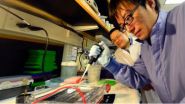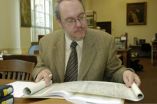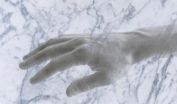(Press-News.org) Pioneering research could provide a significant boost in the vital quest to harness wave power as a viable renewable energy source for the future.
Scientists from the University of Exeter have studied how wave energy developers can more accurately measure, and predict the wave conditions within wave energy test sites.
The research, which is published in leading scientific journal Energy, deployed wave measurement buoys and used wave modelling to show how variations in wave size and strength could be resolved.
The results should aid developers to better predict sea conditions within wave energy test sites, which is the crucial factor governing how much energy can be produced.
This latest study is part of ongoing research by the University and key partners into waves as a renewable energy source. With ongoing support from the Regional Growth Fund, these methods are now being applied to the Wave Hub and FabTest energy test sites in Cornwall, to support industrial partners testing at these sites.
The research has been co-authored by Dr Ian Ashton and Dr Lars Johanning, both from the Renewable Energy department based at the University of Exeter's Penryn Campus in Cornwall and was supported by the National Environmental Research Council (NERC) Flowbec project.
Dr Ashton said: "This research forms part of our work to support developers get the most out of the world class marine energy test facilities and measurement infrastructure that we have in Cornwall, and it is great to be able to support the development of this industry'.
INFORMATION:
FaB Test is a pre-consented two square kilometre area situated within Falmouth harbour between three and five kilometres offshore in Falmouth Bay. The site offers wave energy device developers the opportunity to test components, concepts or full scale devices in a moderate wave climate with excellent access to nearby port infrastructure.
FaB Test's pre-consented status which allows for up to three devices to be deployed concurrently aims to provide a fast, flexible low cost solution for the testing of wave energy technologies, components, moorings and deployment procedures.
The Site is leased from Crown Estates and has a Marine Consent for testing subject to permits issued by Falmouth Harbour Commissioners.
Falmouth, on the south coast of Cornwall, offers both extensive dock facilities incorporating three dry docks, wharf space, cranage and a heavy load out quay; and an experienced supply chain, with an impressive track record in delivering marine renewable projects.
Pioneering research offers new insight into improved wave energy testing
2014-03-24
ELSE PRESS RELEASES FROM THIS DATE:
Maturitas publishes position statement on management of vertebral osteoporotic fracture
2014-03-24
Amsterdam, March 24, 2014 – Elsevier, a world-leading provider of scientific, technical and medical information products and services, today announced the publication of a position statement by the European Menopause and Andropause Society (EMAS) in the journal Maturitas on the topic of the management of postmenopausal women with vertebral osteoporotic fracture.
Vertebral osteoporotic fracture is an underestimated condition as only about a third of people with the disease seek medical attention. While it may cause acute back pain, the presentation may be insidious with ...
Protein called YAP gives blood vessels strength, shape
2014-03-24
AUGUSTA, Ga. - A protein known to promote cancer appears to give the blood vessels strength and shape, researchers report.
When yes-associated protein, or YAP, is deleted from vascular smooth muscle cells during development, the protein makes thin-walled blood vessels that over-dilate in response to the usual pressure of blood flow, said Dr. Jiliang Zhou, vascular biologist at the Medical College of Georgia at Georgia Regents University.
"The thickness of the arterial wall decreases from three or four layers of smooth muscle cells to one or two layers," said Zhou, corresponding ...
From mouse ears to man's?
2014-03-24
One in a thousand children in the United States is deaf, and one in three adults will experience significant hearing loss after the age of 65. Whether the result of genetic or environmental factors, hearing loss costs billions of dollars in healthcare expenses every year, making the search for a cure critical.
Now a team of researchers led by Karen B. Avraham of the Department of Human Molecular Genetics and Biochemistry at Tel Aviv University's Sackler Faculty of Medicine and Yehoash Raphael of the Department of Otolaryngology–Head and Neck Surgery at University of ...
Guarding grapes and other tales from papyri
2014-03-24
If you weren't careful, you might end up beaten by grape thieves skulking in the darkness.
A University of Cincinnati graduate student writes about the contractual obligations of vineyard guards and researchers from around the world contribute more stories from ancient times in the most recent volumes of the Bulletin of the American Society of Papyrologists (BASP).
UC's Peter van Minnen, associate professor of classics, has edited the international journal since 2006. BASP is an annual collection of articles and reviews pertaining to important discoveries from around ...
Lots of carbon dioxide equivalents from aquatic environments
2014-03-24
Large amounts of carbon dioxide equivalents taken up by plants on land are returned to the atmosphere from aquatic environments. This is the conclusions from a study carried out by two students at Linköping University, Sweden.
As students at the Master program Science for Sustainable Development in Linköping, Bala Panneer Selvam and Sivakiruthika Natchimuthu, did a thorough investigation of greenhouse gas emissions from many types of inland waters in India under supervision by Dr Lakshmanan Arunachalam, Tamil Nadu Agricultural University, India, and Dr David Bastviken, ...
A towel less: How psychologists harness sociability to cut waste
2014-03-24
Hotel guests can be gently persuaded to reduce the number of towels they use each day, psychology researchers at the University of Luxembourg have found. With fewer towels to wash, this reduces the waste of water, energy and detergent. This is good news for the environment and it cuts costs, so enabling hotels to reduce prices.
Two hotels in Swiss and Austrian ski resorts helped with an experiment in early 2013. Three different signs were placed separately in different bathrooms, all of which gently reminded guests of the environmental impact of towel use. However, one ...
Microfluidic device with artificial arteries measures drugs' influence on blood clotting
2014-03-24
A new microfluidic method for evaluating drugs commonly used for preventing heart attacks has found that while aspirin can prevent dangerous blood clots in some at-risk patients, it may not be effective in all patients with narrowed arteries. The study, which involved 14 human subjects, used a device that simulated blood flowing through narrowed coronary arteries to assess effects of anti-clotting drugs.
The study is the first to examine how aspirin and another heart attack prevention drug respond to a variety of mechanical blood flow forces in healthy and diseased arteries. ...
Would you believe your hand could turn into marble?
2014-03-24
This news release is available in German.
The study was published in the international scientific journal PLOS ONE on 13 March 2014.
To induce an illusory perception of the material properties of the hand, a group of neuroscientists from Bielefeld University, the Max-Planck Institute for Biological Cybernetics (Germany), and the University of Milano-Bicocca (Italy) asked volunteers to sit with their hands lying on a table in front of them. They repeatedly hit the participants' right hands gently with a small hammer while replacing the natural sound of the hammer ...
Hot nanoparticles for cancer treatments
2014-03-24
This news release is available in German. If you put your hand over a switched-on torch in the dark, it appears to glow red. This is because long-wavelength red light beams penetrate human tissue more effectively than short-wavelength blue light. ETH Zurich researchers exploit this fact in a new kind of nanoparticles: so-called plasmonic particles, which heat up when they absorb near-infrared light. This could enable them to kill tumour tissue with heat, for instance.
Gold is a popular material for nanoparticles used therapeutically, as it is well tolerated and ...
Nature Immunology study finds novel population of neutrophils
2014-03-24
Case Western Reserve University researchers have discovered a novel population of neutrophils, which are the body's infection control workhorses. These cells have an enhanced microbial killing ability and are thereby better able to control infection.
Neutrophils, the body's most abundant type of white blood cells, have long been regarded as first responders that kill fungi, bacteria, and other pathogens. In a study published in the February issue of Nature Immunology, Case Western Reserve researchers explain that they have found the mechanism of action of a newly discovered ...



